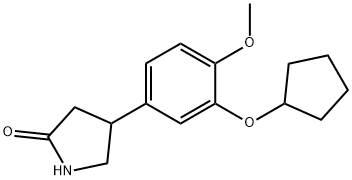| Description | Rolipram (61413-54-5) is a selective inhibitor of cAMP-specific phosphodiesterase (PDE4), IC50 = 1 μM. Displays beneficial effects in neurodegenerative diseases. Rolipram also displays anti-inflammatory activity and synergizes with forskolin (cat.# 10-2073). Cell permeable. |
| Chemical Properties | Yellowish solid |
| Uses | (±)-Rolipram is a cAMP-specific phosphodiesterase 4 (PDE4) inhibitor. |
| Uses | Pharmacological tool for characterization of phosphodiesterase isoenzymes. |
| Uses | A selective, cell permeable inhibitor of cAMP-specific phosphodiesterase (PDE4). |
| Uses | antipsychotic |
| Definition | ChEBI: Rolipram is a member of the lclass of pyrrolidin-2-ones that is pyrrolidin-2-one bearing a 3-(cyclopentyloxy)-4-methoxyphenyl substituent at the 4-position. It is a type IV-specific phosphodiesterase (PDE4) inhibitor. It has a role as an antidepressant and an EC 3.1.4.* (phosphoric diester hydrolase) inhibitor. |
| General Description | A cell-permeable, selective inhibitor of cAMP-specific phosphodiesterase (PDE IV; IC50 = 800 nM). A rolipram-insensitive PDE IV subtype is also known to exist. Also inhibits NF-κB and NFAT activation in Jurkat and primary T cells. |
| Biological Activity | Selective inhibitor of cAMP phosphodiesterase (PDE4) (IC 50 = 2.0 μ M). Discriminates between two conformational states of PDE4 isoenzymes. See separate isomers ((R)-(-)-Rolipram and (S)-(+)-Rolipram). |
| Biochem/physiol Actions | Cell permeable: yes |
| References | 1) Reeves et al. (1987), The identification of a new cyclic nucleotide phosphodiesterase activity in human and guinea-pig cardiac ventricle. Implications for the mechanism of action of selective phosphodiesterase; Biochem. J., 241 535 2) Nishi et al. (2008), Distinct Roles of PDE4 and PDE10A in the Regulation of cAMP/PKA Signaling in the Striatum; J. Neurosci., 28 10460 3) Christiansen et al. (2011), Combined anti-inflammatory effects of β2-adrenergic agonists and PDE4 inhibitors on astrocytes by upregulation of intracellular cAMP; Neurochem. Int., 59 837 |
